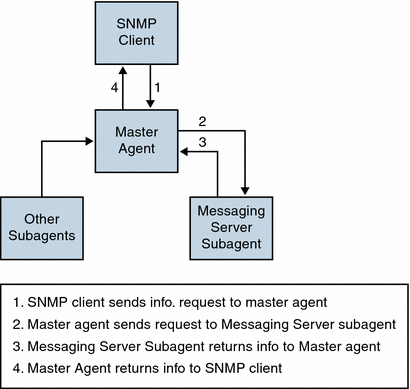SNMP Implementation
Messaging Server implements two standardized MIBs, the Network Services Monitoring MIB (RFC 2788) and the Mail Monitoring MIB (RFC 2789). The Network Services Monitoring MIB provides for the monitoring of network services such as POP, IMAP, HTTP, and SMTP servers. The Mail Monitoring MIB provides for the monitoring of MTAs. The Mail Monitoring MIB allows for monitoring both the active and historical state of each MTA channel. The active information focuses on currently queued messages and open network connections (for example, counts of queued messages, source IP addresses of open network connections), while the historical information provides cumulative totals (for example, total messages processed, total inbound connections).
Note –
For a complete listing of Messaging Server SNMP monitoring information, refer to RFC 2788 and RFC 2789.
SNMP is supported on platforms running Solaris 8 and 9 as well as all versions of Microsoft Windows supported by the Java Enterprise System. Support on other platforms will appear in a later release. The SNMP support on Solaris makes use of the native Solaris SNMP technology, Solstice Enterprise Agents (SEA). Customers do not need to install SEA on Solaris 8 systems: the necessary run-time libraries are already present.
Limitations of the Messaging Server SNMP support are as follows:
-
Only one instance of Messaging Server per host computer can be monitored via SNMP.
-
The SNMP support is for monitoring only. No SNMP management is supported.
-
No SNMP traps are implemented. (RFC 2788 provides similar functionality without using traps.)
SNMP Operation in the Messaging Server
On Solaris platforms, the Messaging Server SNMP process is an SNMP subagent which, upon startup, registers itself with the platform’s native SNMP master agent. SNMP requests from clients go to the master agent. The master agent then forwards any requests destined for the Messaging Server to the Messaging Server subagent process. The Messaging Server subagent process then processes the request and relays the response back to the client via the master agent. This process is shown in Figure A–1.
Figure A–1 SNMP Information Flow

- © 2010, Oracle Corporation and/or its affiliates
